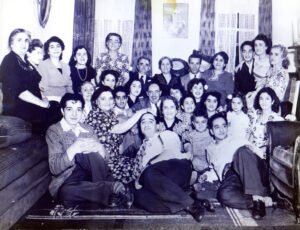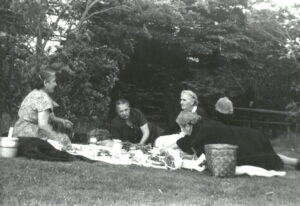Lebanese-Newfoundlanders Creating Community
The pioneer Lebanese immigrants to Newfoundland thrived because of their determination, wise financial decisions, diligence, resilience, and support from family members. Community was important to these new Newfoundlanders. Food, music, and gatherings played a large part in developing the Lebanese community’s sense of place.
In this video Lillian Basha George of Corner Brook (formerly of Curling) walks Andrea O’Brien and Lara Maynard of Heritage NL through the process of cooking fatayas. Fatayas are a type of pastry turnover filled with meat or spinach. They are a traditional Lebanese food Lillian makes for Christmas and large gatherings. View this video with additional information (EN).
Lillian’s father’s family moved to Curling from Lebanon in the late 1890s. Her grandfather, Thomas (Tanius), established Tanius Basha and Sons in Curling. Her father, Simon, and two uncles, Elias and Mike, worked in the family business before starting their own. Her mother’s family of Bashas came from Baalbek, Lebanon. They immigrated to Newfoundland and settled on Bell Island.
In this video Marie Daniels of Corner Brook (formerly of Curling) walks Andrea O’Brien of Heritage NL through the process of cooking stuffed grape leaves. Marie’s husband, Tom, is a Lebanese-Newfoundlander and she started trying Lebanese dishes when they were dating. Tom’s parents were both Lebanese immigrants. His father was a Daniels and his mother was a Basha. When they married, Marie learned from her mother-in-law how to cook traditional Lebanese dishes. View this video with additional information (EN).
Marie makes grape leaves as a side dish or as an appetiser for large gatherings, particularly during the holidays.
Food plays an important part in maintaining a link to Lebanon. Many families make Lebanese food using English or Lebanese words for the dishes. Families gather together to prepare large portions of Lebanese dishes. Community members grow grapes and kousa (squash) as ingredients for certain dishes.
Wyatt Shibley describes the importance of food to the Lebanese-Newfoundland community. Enjoy this audio clip with transcription (EN).

Gathering of the community at Bedra and Habib’s to welcome a visitor from Lebanon. Circa late 1940s.
The Lebanese-Newfoundland community creates connection through gatherings and events. With the demolition of the New Gower Street neighbourhood, the close-knit ties of many Lebanese families in St. John’s diminished as they spread and settled across the city. More recently, Saliba Dominic’s granddaughter co-ordinated an annual gathering of Lebanese-Newfoundlanders, through the Lebanese Association of Newfoundland and Labrador.
Lorraine Michael describes the gathering of the Lebanese Association. Enjoy this audio clip with transcription (EN).
In addition to music and food, a sense of place is created through the objects shown in the homes of many Lebanese-Newfoundlanders. This includes artistic renderings of jurns (also spelled jeren; a large mortar and pestle often made of wood or rock). It also includes cedar objects such as artistic wood burnings or wooden depictions of cedar trees. Cedar is the Lebanese national emblem. Music, food, objects, and events have helped Lebanese-Newfoundlanders maintain a connection with Lebanon and their history for over five generations.
Wyatt Shibley describes his research with the Lebanese-Newfoundland community, and the material culture the community displays in their homes. Enjoy this audio clip with transcription (EN).


